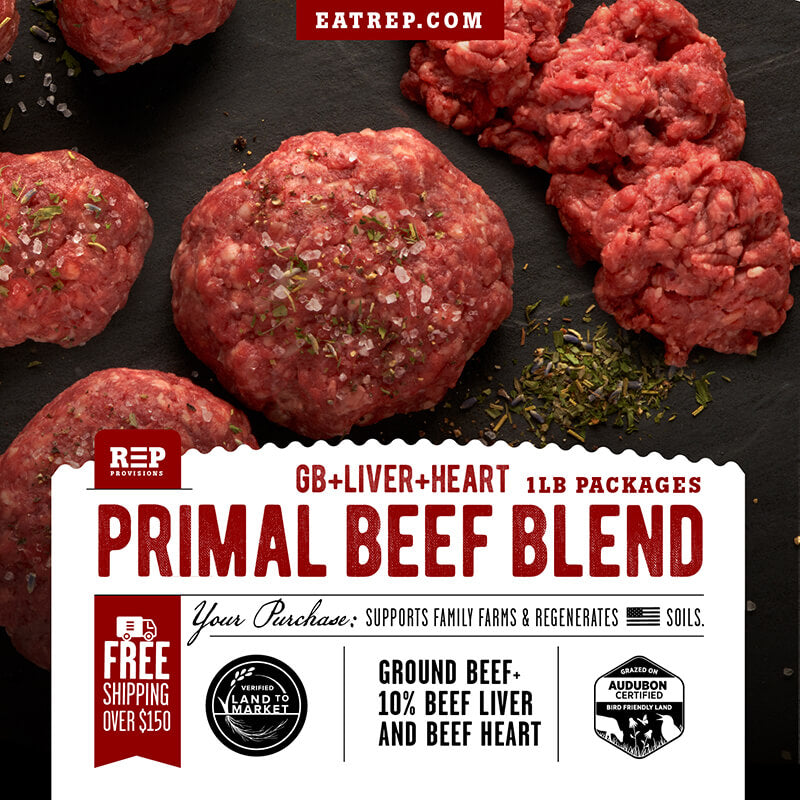
Ancient wisdom backed by modern science: 7 nutrients you need for optimal fertility.
Throughout the ages, fertility has been revered, celebrated, and sought after. At its core, fertility embodies the very essence of life’s continuation.
While fertility is a natural process, it is not immune to challenges and complexities. In this blog, we’ll be exploring the connection between the food on your plate, the farm where it came from, and your fertility journey.
Infertility in the Modern World
Worldwide we’re experiencing a massive decline in fertility, both on our farmlands and inside our very own bodies.
Today, infertility – an inability to conceive after a year of trying – is a pretty big issue. Roughly 15% of US couples are considered infertile, with 1 in 4 struggling to conceive. Our modern diet, environment, and lifestyle all contribute to rising infertility rates.
Although the rise of industrial agriculture has supplied humanity with an abundance of calories, the caveat is that they’re emptier. As we deplete our soils through irresponsible farming practices, like monocropping and clear-cutting forests, we’re no longer able to produce nutritious foods.
Further exacerbating the problem, in the absence of healthy soil conventional agriculture uses synthetic pesticides–many of which are known endocrine disruptors. Essentially, our current food system is not working.
You’ve likely heard that bioengineered foods, lab grown meat, and a plant-based diet will save the planet and make you healthier; but what if the solution isn’t new technologies or diets?
What if the solution lies in centuries old farming practices that have proven themselves time and time again to restore ecosystem and bodily health?
From Pasture to Plate, Can Cows Restore our Fertility?
Contrary to popular belief, cows and red meat are not inherently harmful. In fact, it was only when we started overgrazing, raising livestock in feedlots, feeding them grains, and injecting them with antibiotics and hormones that problems began.
Before industrial agriculture, regenerative agriculture was the norm. At its core regenerative agriculture is farming and ranching in harmony with nature. It’s a farmer-led approach to land management which prioritizes community well-being as much as it does profits.
For example, on REP’s ranches we practice rotational grazing, mimicking the grazing patterns of bison herds in order to stimulate new plant growth, naturally fertilize (manure/urine) the soil, and transform previously inedible plant material into nutrient-dense foods.
Our cattle play an important role in maintaining the overall health and fertility of our grassland ecosystem; in fact grasslands need grazers. Every year we collect data to ensure our farming practices enhance biodiversity, restore water and soil health, sequester carbon, and conserve/create wildlife habitat.
Regeneration is all about promoting the interdependence between species and cycles to keep nature’s systems in check as well as create our desired outcomes. Healthy lands and healthy livestock equally support one another. This means we don’t need to use antibiotics, hormones, or mRNA vaccines like conventional ranchers do.
Studies linking red meat to infertility aren’t looking at regenerative beef. Conventional grain-fed beef develops an inflammatory fatty acid profile, high in omega-6’s and low in anti-inflammatory omega-3’s. Given that inflammation is known to play a role in many reproductive disorders, studies linking red meat with infertility wrongfully demonize meat as a whole, when conventional agriculture is to blame.
Our ancestors relied on the cow, so why should it be so different now?
Ancestral Fertility
Spanning thousands of years, various societies worshipped fertility gods and goddesses depicted as or with cattle. Ancient civilizations constructed grand temples and performed rituals, symbolizing the immense importance of the cow in regards to productive farmland and reproduction.
In contrast with modern humans, our ancestors' biggest fertility issues were caused by a lack of food paired with too much physical activity. When your body lacks nutrients it puts all of the energy towards keeping you alive, rather than reproduction.
Around the world, traditional hunter-gatherer societies addressed this by feeding women extra meat, fish, and organ meats around six months prior to conception. By examining traditional wisdom through the lens of modern nutritional science, it’s easy to see why animal foods were so highly prized by our ancestors.
Animal foods like beef are a near-perfect package of bioavailable protein, vitamins, minerals, and fats needed for optimal reproductive health.
But, what does bioavailable mean? Bioavailability refers to the amount of a nutrient your body can easily absorb. It’s important to recognize that even if a food has a certain nutrient, it may not be bioavailable. If it isn’t, your body needs to work really hard in order to convert it into a usable form, which isn’t very efficient.
Fertility Fuel: 7 Vital Nutrients in Regenerative Grass-Finished Beef
Omega-3’s Fatty Acids (EPA & DHA)
-
Omega-3’s are notoriously anti-inflammatory. Unbeknownst to many, seafood is not the only source of these vital fats. Our beef’s omega-3 levels rival that of wild caught salmon. Learn more here.
- Both EPA and DHA help regulate hormone production and function, support ovulation, protect eggs from oxidative stress, and create a healthy uterine lining. Higher levels of EPA and DHA enhance sperm production, motility, and morphology.
- Most importantly, DHA represents about 97% of all omega-3 fatty acids in the brain. Studies show babies whose mother ate a diet rich in DHA and EPA developed stronger problem solving skills and hand eye coordination than those who did not.
Vitamin B12:
- Vitamin B12 isn’t found in sufficient amounts in plant foods. Period. Vegetarians and vegans struggle to get this essential nutrient. Deficiencies may cause anemia, fatigue, depression, and infertility in both men and women.
- B12 is crucial for the creation and maintenance of red blood cells, nerve cells, DNA, RNA, neurotransmitters, and the production of healthy eggs and sperm.
Zinc:
-
There’s a higher concentration of zinc found in the testicles than anywhere else in the human body. Males with low levels of zinc intake have low testosterone and poor sperm quality.
-
In females, low zinc can disrupt the menstrual cycle, slow the production of good quality eggs, and increase the chances of miscarriage.
- Zinc benefits include strengthening bones, boosting your immune system, and increasing energy levels. Zinc also supports the rapid growth of cells during a pregnancy, making it one of the most important nutrients for babies and mothers.
Iron:
- Red meat is a rich source of bioavailable heme iron, which is at least 3X more bioavailable than non–heme iron, found in plant-based foods. Women who “beef up” during preconception generally have a higher fertility rate than those who do not.
- There is a clear link between poor pregnancy outcomes and low iron intake. Both pregnant women and infants are at a considerable risk of developing iron deficiency because both groups must absorb more iron than is lost from the body during this rapid period of growth.
Vitamin B3:
- Pregnancy and breastfeeding requires healthy levels of B3, also known as Niacin. It’s important to include it in your diet every day because it cannot be stored in the body.
Selenium:
-
Selenium is a trace element necessary for a properly functioning reproductive system. Deficiencies may lead to gestational complications, miscarriages, and damage to the nervous and immune system of the fetus. Low concentrations of selenium in the early stage of pregnancy is a proven indicator of low birth weight.
- Bonus, it also improves sperm motility, morphology, and quality. Grass-fed & finished steaks support healthy sperm.
Folate
-
Folate, a B vitamin, helps increase live birth rates and prevents birth defects in the spine and brain during the first few weeks of development.
- While it’s commonly supplemented, the best way to absorb folate is by eating it in a whole and balanced diet.
Vitamin A (Retinol)
- Vitamin A is involved in regulating the growth of almost every cell in you and your baby's body–from vision to a healthy immune system. Animal sources are the most reliable and absorbable forms of vitamin A.
3 Regenerative Products We Recommend For Fertility
Liver, the Often Overlooked Fertility Superfood
Organ meats were consumed in nearly every indigenous culture, known widely as nature’s multivitamin. Beef and chicken liver in particular are a potent source of protein, iron, vitamin A, B12, and folate. Just 100g of beef liver provides 338% of the daily recommended vitamin A.
If whole pasture raised chicken livers aren’t your style, try our primal beef blend. This way you can experience the familiar taste of ground beef, with the added nutritional value of organ meats.
BUY PRIMAL BLEND
Regenerative Bone Broth
Preservative free, bone broths contain good fats, proteins, vitamins, and minerals. Collagen found in bone broth is the richest source of glycine and amino acids on the planet.
Whether trying to conceive naturally or with IVF, bone broth helps to heal gut issues, restore the connective tissues in the pelvic bowl, and balance your hormones, not to mention it’s delicious and easy to drink. We offer both chicken and beef bone broths, pre-made or DIY.
REP Provisions Verified Regenerative Beef
All of our beef and meat products are full of bioavailable fats, minerals, and vitamins you need to boost your fertility. See what our customers are saying for yourself and learn more about our Land to Market Verified Regenerative seal here .
*Disclaimer: Of course, we are not medical doctors and you should consult a doctor before implementing any major dietary changes before or during pregnancy.*
https://carsey.unh.edu/publication/snapshot/US-fertility-rates-births-continue-to-diminish







